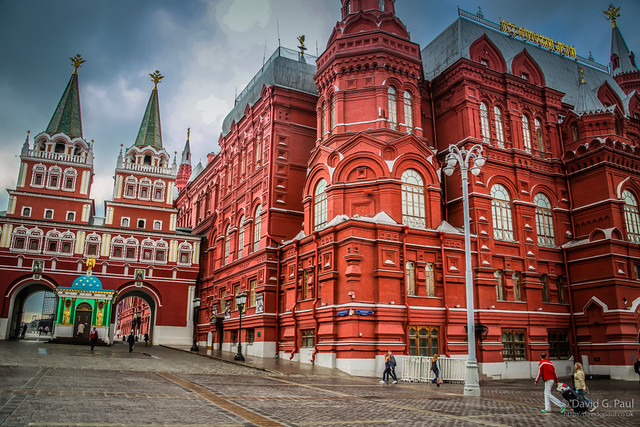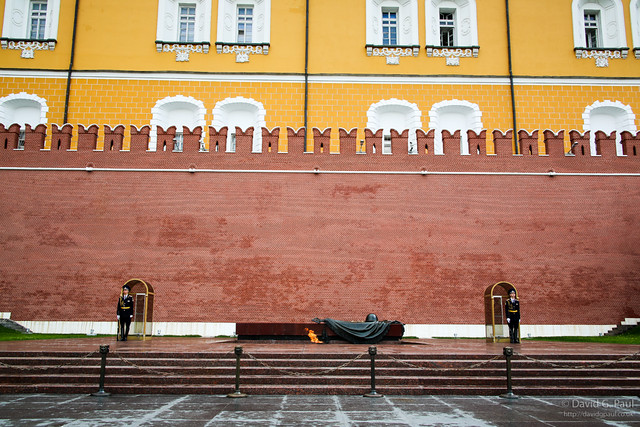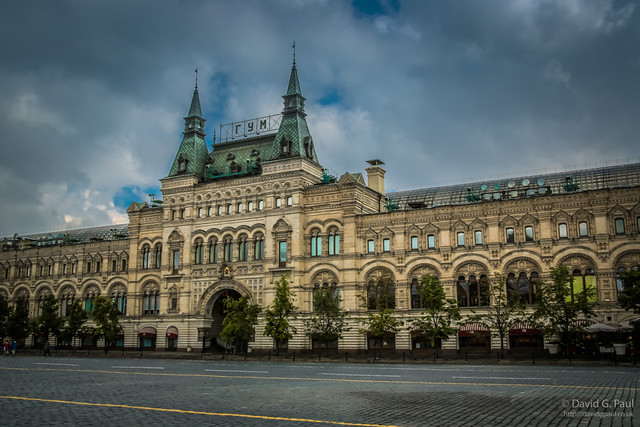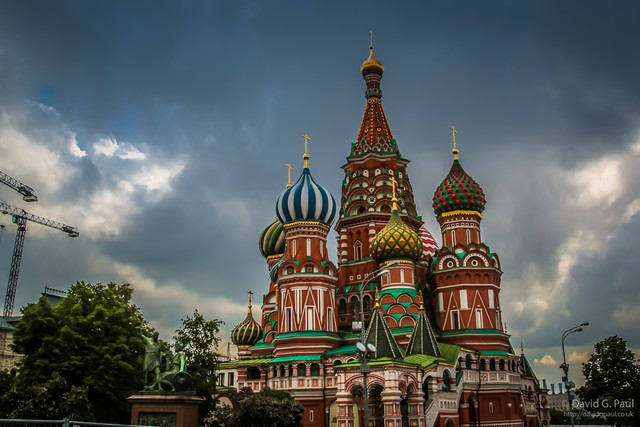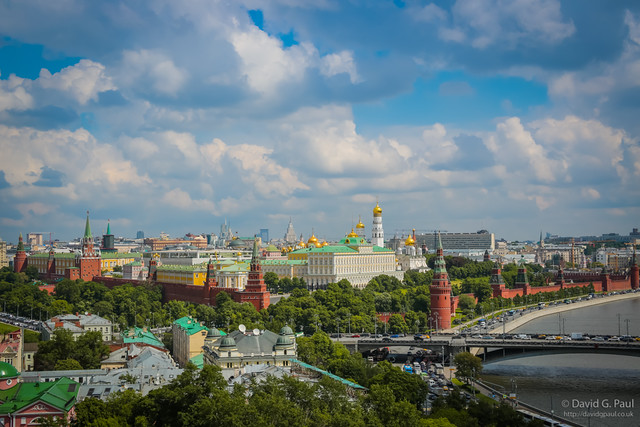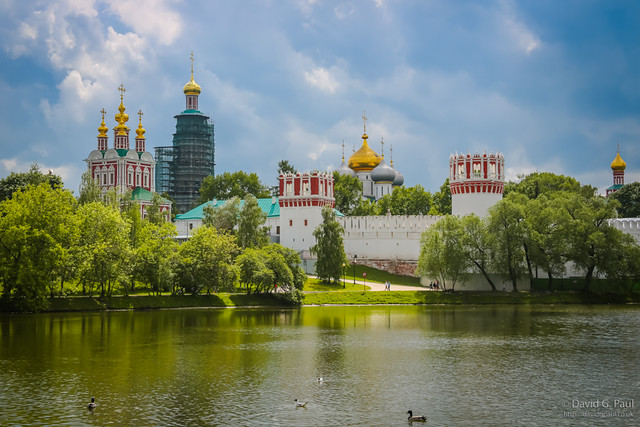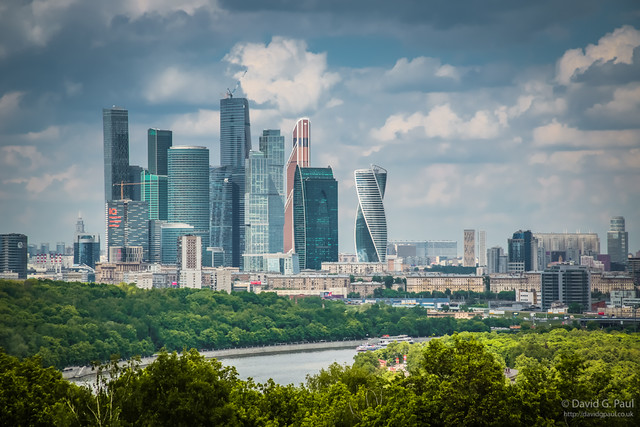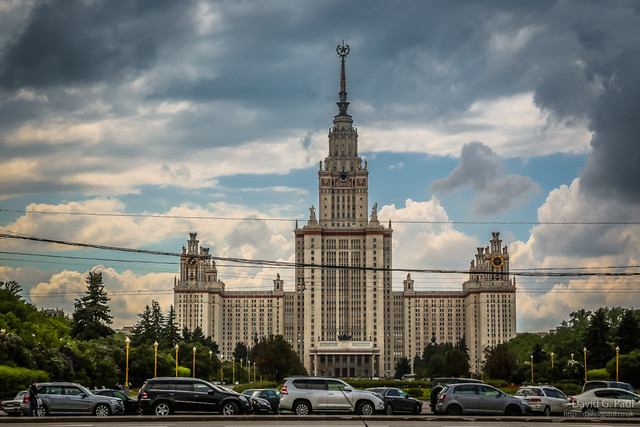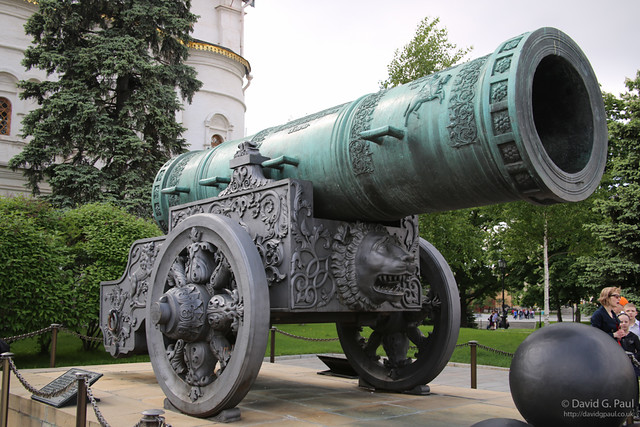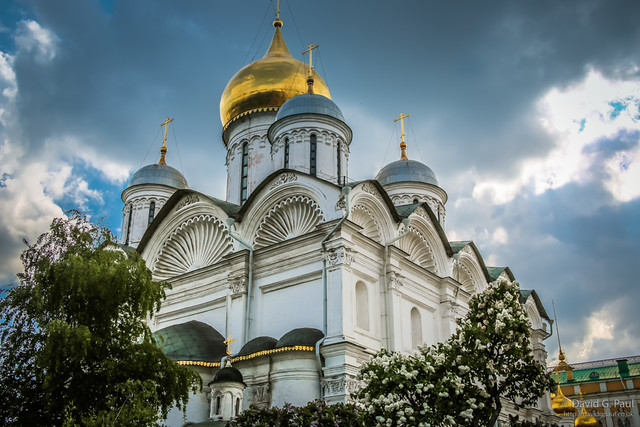A bumpy train ride had meant a mostly sleepless night for me when I got up for breakfast a little before 07:00. For breakfast I had a few warm pancakes spread with jam, but the rest of the breakfast I didn’t eat but included a croissant, an orange, and some bad tasting cheese.
We pulled into Moscow at 07:40 and was met by Vlad who would be our guide for the day, and would meet again on our return to Moscow. Our first stop was near the Metropol hotel, but before we could get started we both needed to sort out our camera backpacks so that we could walk with lighter bags.
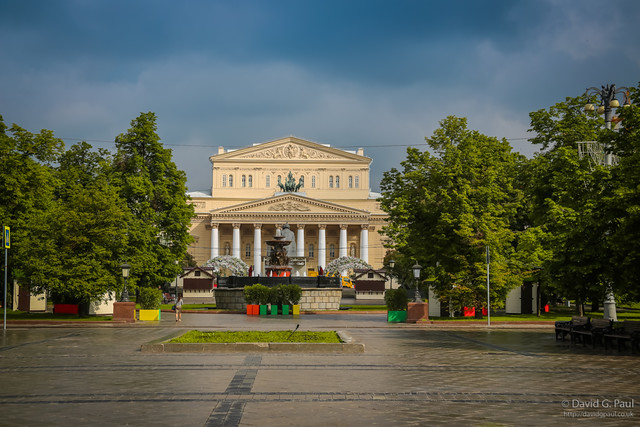
The walking tour started at Teatralnaya Square and Revolution Square with details about all the buildings that surrounded us and continued along the route into the Alexander Gardens alongside the Kremlin. Before entering Red Square though our guide left us for 15-20 minutes whilst he went off to get the tickets we would need for the day.
Once into Red Square we were told about the history of the Kremlin, the mausoleum and the graves of Communists along the wall including the cosmonaut Yuri Gagarin, the first human in space. He then continued on with the history of other buildings such as the GUM (Gosudarstvennyi Universalnyi Magazin which translates to “State Universal Store”) which has been a centre of trade since at least 1812.
As we moved on to Saint Basil’s Cathedral we didn’t get to go inside, but lingered outside long enough to take photographs of it’s world famous spires as he told us about it’s previous name and the history behind it.
The official name of this UNESCO World Heritage site is the church of the Intercession of the Most Holy Theotokos on the Moat. It’s commonly known name on Western countries comes from a bad translation of “Church of Vasily the Blessed” – one of the double vaulted sections of the building. It’s construction began in 1555 by Ivan the Terrible, over the grave of Saint Vasily (Basil) as a way of commemorating the Kazan victory.
After Vlad had finished telling us about these buildings and their history he gave us the choice of either going inside the mausoleum that is the final resting place of Lenin and Stalin, or to go on the planned metro tour. We felt we could come back and do the mausoleum easily enough another day and that seeing how the metro worked could be useful for when we’d need to use it by ourselves.

The very first metro station we entered turned out to be very well decorated – much better than any of the ones I’ve seen in London, and reminded me a little of Museum station in Toronto in terms of decorative quality. Our guide then took us to several other stations that had mosaics and stone carvings depicting different parts of Russian history and culture, some of which was strong with Communist imagery such as the mosaic whose background was a five-pointed star and the hammer and sickle.
Once our tour had finished there we were taken to the Cathedral of Christ the Saviour. This is a cathedral which was not built by the church, but by a company who created it as a business investment and let the church use it for services. A church had stood there previously but with the change to atheism during the Soviet era it had been knocked down and the ground flattened to make way for a skyscraper. This however never got built so in recent years the cathedral was rebuilt, but due to the lowered ground they raised it to it’s original height by giving it a cellar.
This cathedral does not allow the use of cameras inside as it’s used for worship, but with a local guide they can take you up onto it’s roof so you can get a good view of the city. On the roof they do allow photographs to be taken. Whilst going around the roof we were told the history of many more buildings, and some was repeated from what we’d been told in the morning.
As it was now around 14:00 we asked if we could go somewhere to get food, so our guide called for the driver who had dropped us off first thing in the morning and drove us to a nearby cafe. I went for a piece of chicken (which was cold), mashed potatoes, and green beans. My friend had ordered similar, but was overcharged as he’d paid for two pieces of chicken but only got one of them. It was only a difference of 90 roubles though so wasn’t much.
We were then driven to the Bolshoy Novodevichy Prud which we were told was the inspiration for Swan Lake – though it doesn’t appear to be referenced in any literature about Tchaikovsky’s masterpiece so wasn’t sure how true this was. This one was located behind the Novodevichy Convent which we’d see the following week upon our return.
The next stop was quite a drive out of the city and was to a viewpoint that overlooked a couple of stadiums and a ski jump. Behind us we could see the Moscow State University, and we were told to not worry about taking photographs of it yet as with the tram cables in the way we’d go closer to it. We didn’t though, instead Vlad got the driver to head back to the city centre for our scheduled 15:15 tour of the Kremlin.
The traffic on the way back was bad and eventually we got out of the car and went the rest of the way by metro, but it was only three stops so wasn’t too far. Although we’d arrive about 20 minutes early we were still allowed to check-in our backpacks at the baggage drop and to enter the Moscow Kremlin.
The Moscow Kremlin is one of many Russian citadels (Kremlin translating to citadel) but is often referred to as just “The Kremlin” due to it being the most famous and important of them. The site of the Moscow Kremlin at the side of the Moskva River has been inhabited since the 2nd century BC and by 1237 had become a fortress that was destroyed by the Mongols. In 1339 the fortress was strengthened with oak walls which were eventually replaced 30 years later with the white limestone that was often used in Moscow buildings.
It was around the time of the construction of the limestone walls that the cathedrals inside the Moscow Kremlin were built. Then between 1485 and 1508 the walls were redesigned to how they appear today and the towers, including the Ivan the Great Bell Tower, were constructed. A 30 metre wide moat was later added to further defend this citadel, along with further rings around the city that were later replaced with “garden rings”.
The Kremlin was abandoned during the reign of Peter the Great, and was damaged much later during the occupation of Napoleon’s forces during the Peninsular war. During the Soviet era the capital moved back to Moscow and the Kremlin once again became the seat of power and symbols of the Tsarist times were destroyed.
Once inside we were told about the administrative buildings, the great palace, and a few of the cathedrals that surround a square. After every few steps we took, Vlad would stop and tell us another piece of history, even if it was something he’d already told us. One of the new bits of information we got though was about the Tsar cannon and the Tsar bell. In the case of the canon it was one which used to sit in Red Square as a show of power, but was never used. Eventually it was moved to inside the Kremlin for display and a carriage added to it.
In the case of the bell, we were told that it was a tradition for each Tsar to create a new bell and this one when created by Empress Anna Ivanova – the niece of Peter the Great. As it happens our guide was incorrect with it’s history – it’s actually only the third generation of the bell. It was too heavy for it to be lifted upon it’s completion, so instead they constructed a mechanism underneath it for the bell to ring for the coronation. Eventually though it was damaged due to the contrasting temperatures between a raging fire that had broken out and the cold temperatures of the snow that surrounded it.
The weight of the Tsar Bell is so great that even when Napoleon occupied Moscow during the Peninsular war, he was unable to remove the bell and take it to Paris as a trophy as planned due to it’s immense weight.
We went inside two of the cathedrals: the Assumption Cathedral and the Archangel Cathedral. Both of these were incredibly busy, and by this point we were tired and our feet were aching from the amount of walking we’d done over the past few days. The guide didn’t really care though and insisted on telling us about each of the paintings and parts of the cathedrals, even if the story repeated bits he’d already told us. By this point I was getting incredibly bored and felt that a self-guided tour of the Kremlin may have gone better.
When we’d finished at the cathedrals we entered the armoury building and jumped at the chance to pay 500 roubles to go around the Diamond Fund exhibition without the guide. It wasn’t really something I was interested in, but I looked around anyway just for some quiet time. Apparently this collection is comparable to the Crown jewels in England. It was originally started by Peter the Great and held in the Winter Palace and was added to by each Tsar after this. During the time of the Soviet Union and the first World War the collection was moved to Moscow, and was put on public display in the 1960s as a permanent exhibition.
Once we’d done in the Diamond Fund we were back to being led around the armoury. This entire building, as with the cathedrals earlier, did not allow photography so we had little choice but to listen to the guide. It might sound awful, but when you’ve got a guide that genuinely never stops talking it starts to grate after several hours. For over an hour the guide led us around the exhibitions, describing every single exhibit on show – that was until one of the members of staff told the guide to hurry up as they wanted to close. This was a bit of a relief and the remainder of the armoury tour was rushed.
This brought the tour of the Kremlin to a close. We had to exit through the Alexander park to get back to the baggage drop to collect our backpacks – but it wasn’t that straightforward. Due to a concert that was taking place in the Kremlin they’d closed off one entrance and were directing people to the other. Once there they let the guide and my friends through but then stopped me from going through being told I couldn’t pass. I shouted to my friend as I’d got the token for collecting the backpacks, and one of the guards that were passing by came over and stood behind me. When my friend came back they told him he couldn’t go in either, even though he already had been, and made him leave.
It was getting frustrating – we weren’t sure at this point what to do so shouted for Vlad as he could at least translate for us. Instead of figuring out what was going on he took the token for us and collected our bags. Afterwards we found that due to the concert they were only letting people through with concert tickets at that entrance, and if you needed to collect your bags you’d be allowed through the other entrance. If only there had been some attempt to explain that, but they had no patience.
Once the drama was over our guide asked us if we wanted to walk over to Red Square or go to find some food – we opted for food as we weren’t sure what we’d be able to get at the airport. Instead our guide decided he’d take us for a walk instead, and then asked us again what we wanted to do – again we repeated that we’d like to go for food. He then led us back to where we’d started the day, and asked if we’d like to walk back to the Cathedral of Christ the Saviour we’d seen in the morning.
We kept having to repeat ourselves that we didn’t want to walk any more and wanted to get food. Eventually Vlad took notice and called for the driver, but instead of going for food he told us he was taking us to the airport. When we set off it was 18:35, so we had quite some time until we needed to be there, but due to an accident on the road we were stuck in very slow moving traffic for the next 1hr30. Once we’d passed the accident it was another 45 minutes to the airport and we got there with little time to spare.
Upon entering the airport we had to go through security for all our bags first, and could then go to the baggage drop for the airline. We told Vlad we were flying business class, but instead of joining that queue which was virtually empty he insisted we joined the main queue. This same thing happened when he led us to the queue for security so then had another long wait instead of going straight through as we should have been able to.
There wasn’t much time for food by this point, but I bought a turkey sandwich and drink for 750 roubles. Just 15 minutes later, at 22:15, the gate opened and following a private transfer from the gate to the plane we were on the plane to Irkutsk.

